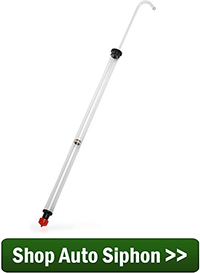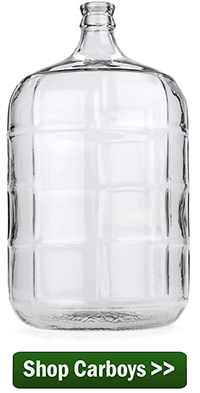 I’m making a batch of wine from one of your wine making kits. I have the wine brewing in a plastic fermenter and it should be reaching a specific gravity of 1.010 tomorrow according to my wine hydrometer. It’s still bubbling actively after 7 days. According to the directions that came with the wine kit I should be racking the wine into a secondary fermenter at this point. Why rack wine into a secondary for the rest of the fermentation? Can’t I just leave it fermenting for another 12 days in the same container….don’t understand why the transfer is necessary at this point.
I’m making a batch of wine from one of your wine making kits. I have the wine brewing in a plastic fermenter and it should be reaching a specific gravity of 1.010 tomorrow according to my wine hydrometer. It’s still bubbling actively after 7 days. According to the directions that came with the wine kit I should be racking the wine into a secondary fermenter at this point. Why rack wine into a secondary for the rest of the fermentation? Can’t I just leave it fermenting for another 12 days in the same container….don’t understand why the transfer is necessary at this point.
Thanks,
Tony F.
———-
Dear Tony,
This is a question we get from time to time, and you’re right, it doesn’t seem to make sense, particularly when you are dealing with concentrated homemade wine kits. Why rack wine to a secondary fermenter when is seems to be fermenting perfectly fine?
When you make wine from fresh fruits, the juice is fermented with the skins and pulp for the first few days so that the juice can extract body, flavor and color. This is a process call maceration. Siphoning the wine after a few days seems logical in that situation. You need to get the skins and pulp out of the way; racking the juice to a clean fermenter seems like a good way to do it.
But there’s another reason why we rack wine into a secondary fermenter besides just getting skins and pulp out of the way, and it’s why you need to rack the wine now, even though it’s from concentrate with no skins or pulp involved. It’s called sediment or lees.
Whether or not there’s skin or pulp, a heavy layer of sediment will develop in the bottom of your wine fermenter. It’s primarily made up of yeast cells that were produced during the fermentation. Having excessive amounts of this sediment in contact with the wine over extended periods of time can cause off-flavors to become noticeable in the resulting wine.
Most of the off-flavors stem from the fact that some of the active yeast cells will try to consume the dead yeast cells that lie at the bottom as the sugar starts to run out. This is a process known as autolysis. So for a clean tasting wine you need to get the wine off the bulk of this sediment. And, this is why you need to rack a wine into a secondary fermenter.
Just as the wine instructions that came with your wine kit imply, it’s usually around the 7th day that almost all of the fermentation has completed, and the activity begins to slow down. This makes it an opportune time to get the bulk of the sediment out of the way. There will be more sediment to follow as the wine clears up, but not nearly as much as the fermentation will have at this point in the process.
Happy Winemaking,
Ed Kraus
—–
Ed Kraus is a 3rd generation home brewer/winemaker and has been an owner of E. C. Kraus since 1999. He has been helping individuals make better wine and beer for over 25 years.

Question:
I have 108 litres of red wine/juice that has fermented for 10 days now and I have not introduced and metabisulphite to it yet other than the remains from washing my carboys. Should I put a campten tablet in/gallon when I rack it…assumming I should rack now?
If not, When?
I’m making Elderberry wine for the first time. I’ve done the primary fermentation in a bucket but did not use a bag for the fruit. I scooped out as much fruit as I could and squeezed the juice. When syphoning to the carboy I think some fruit pulp (not lots) has transferred to the carboy. Is this a problem with flavour and clarity, or should I transfer it again using a muslin? After reading it seems best to leave it alone as I don’t want to mix it unnecessarily with oxygen. Its been bubbling away nicely for 4 days in the carboy now.
Thanks for your blogs, great for us newbies
Rebecca, as long as it is a small amount it will probably be fine. However, if it is a significant amount, I would recommend removing it. The reason that you do not want to leave the fruit pulp in too long is because it can add too much tannin to the wine and cause it to become bitter.
It is ok to add sulfites to the wine after the first racking, but only if the fermentation has completely finished. This needs to be verified with a hydrometer reading. Visual inspection is not good enough. If the fermentation is complete you will expect a reading of .992 to .996. You will also want to add sulfites to the wine right before bottling as well. You may also want to add sulfite after rackings done between now and bottling. A Titretter and Titrets can be purchased on our site. They will allow you to test/track the sulfite level of you wine while in storage.
Forgot about my crabapple wine and it has been in the First primary fermentation stage for 6 months…with crushed crabapples in a mesh bag . On top it has bubbly foamy stuff and it dosent smell bad, kinda smells good …can this still be saved? Thanks, Lola
Lola, it is possible for the wine to be okay and not spoiled. The biggest concern is taste. When pulp is left in the wine for such a long period of time the usual result is a very bitter wine. My only advice to you is to remove the pulp; taste the wine and judge for yourself.
Why does my wine sometimes get bitter? I make many different wines, from plum, grapes ,and from kits. I always make sure the fruit is ripe. I have a recipe book too. CONFUSED..
Thanks, Laura
Laura, the are lots of reasons as to why a wine can end up bitter, but it is usually related in some way of to having too much tannin in the wine. This is one of the main components that is extracted from the fruit while the pulp is still in the fermentation. If you are consistently getting bitter wines, you may want to consider leaving the pulp in the fermentation for a shorter period of time, and/or, don’t process the fruit so finely. If you are chopping the fruit, chop it less. If you are crushing the fruit crush it less. Both too much time in the fermenter and over-process are the main culprits for a bitter wine. One thing that is on your side is time. A bitter wine will most times improve dramatically when given time to age — at least a year and maybe even two. You may also want to consider treating a bitter wine with bentonite. This is a fining agent that is especially good at dropping out tannins and other proteins from the fruit.
I’m new to wine making and I put my wine on airlock as soon as I added yeast and sugar I’m making wine from fruit juice by the way. I read I should have the lid off until primary fermentation is done usually 5 to 7 days did I mess my wine up by leaving the lid on y til day for?? I do see tiny bubbling and fizzing going on when I take the lid off please help when should I rack it into an airlock container??
James, you did not mess up your wine. We recommend not using the airlock during the primary stage so that oxygen can reach the yeast to help it multiply. Whether or not you use an airlock during the primary fermentation, the wine will be made. It’s a matter of how fast and vigorous the fermentation proceeds, not a matter of whether or not your wine will turn out, so don’t feel that it is a critical decision because it’s not. Normally, you want to rack the wine to the secondary fermenter and attach the airlock within the first 5-7 days.
I’m a newbie at this too. Watched a couple of YouTube vids, and thought I’d try the unpresered grape juice. I had some D47 (I was gonna try some mead, but the first batch turned out super dry). Since this was an experiment, I only made a gallon. 100% grape juce, 2 lbs of sugar, and a package of D47. Shook this up, added an airlock, and stuck it in my basement, 3 weeks ago. I sampled it, after a week. Ultra sweet! Tried it a few days ago, and it’s getting better. It’s still pretty murky. What I’m seeing here, I should have left it open, with a towel over it, for 4 days, then put it in a glass jug, with the airlock? Should I just let it ride, until it clears? The yeast is still working. I’m still getting bubbles. Thanks
Al, the reason we say to simply cover the fermenter with a towel and not an airlock during the primary stage is to allow a little air to reach the yeast. The oxygen during this time will help the yeast to multiply. At this point, you want to leave the airlock attached. It will still ferment, it just may take a little longer. You will know the fermentation is complete when the specific gravity reading on the hydrometer is .998 or less.
I am on day 6 of fermentation and placed my wine in secondary fermentation with airlock yesterday. I am using fresh scuppernong grapes, and yielded about 1.5 gallons of juice. I used a blanc yeast and yeast nutrient. This is my first ever experience with wine making and I didn’t realize I needed to add the pectic enzyme or campden tablets. I also haven’t added any potassium sorbete. I’m unsure what to do.
Angela, you can add pectic enzyme now, since you did not add it in the beginning, i would add a double dose. You can go ahead and add the capmden tablets now. If you do so, you will need to add another packet of yeast because the campden will more than likely kill most of the yeast.
I’m fermenting a pumpkin wine. It never got too foamy like my plum wine, but is also very slow to ferment. Original gravity was fairly high due to I assume the sugar amount. OG: 1.09. It has stayed in the primary for 11days and we are only at 1.045. Should I A) proceed to secondary and let it finish out there, or B) let it sit several more days in primary? —- still lots of tiny bubbles but no foam to worry about if moves to secondary. —- will moving to 2nd stop fermentation? I feel that secondary is a safer environment than primary (contamination)?
Michael, if it has been in the primary for 11 days without an airlock, I would go ahead and rack it to the secondary fermenter and get it under the airlock. Moving it to the secondary will not harm the fermentation other than it might take a bit for it to start up again.